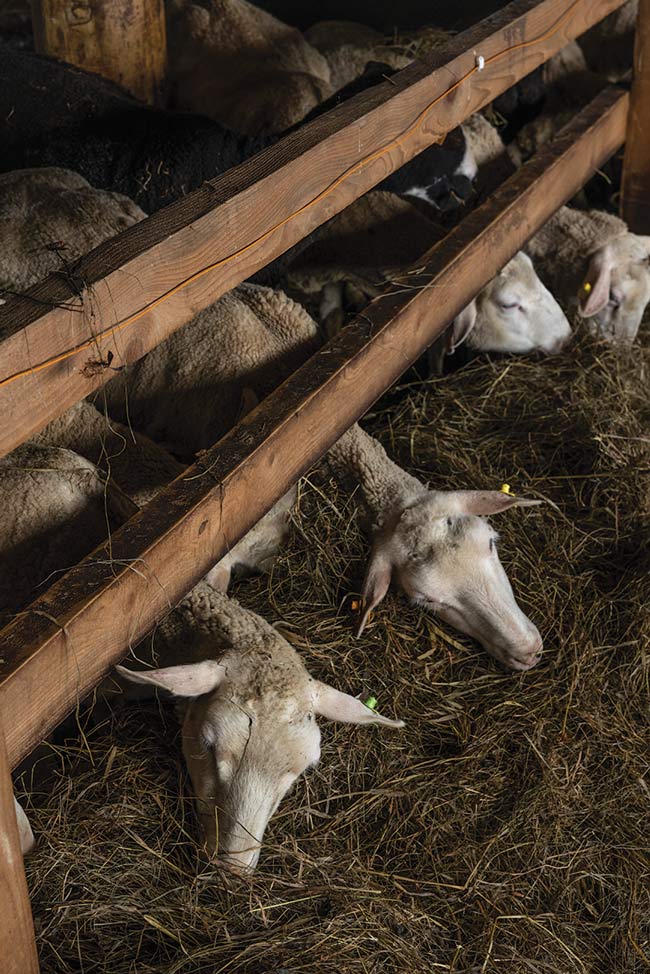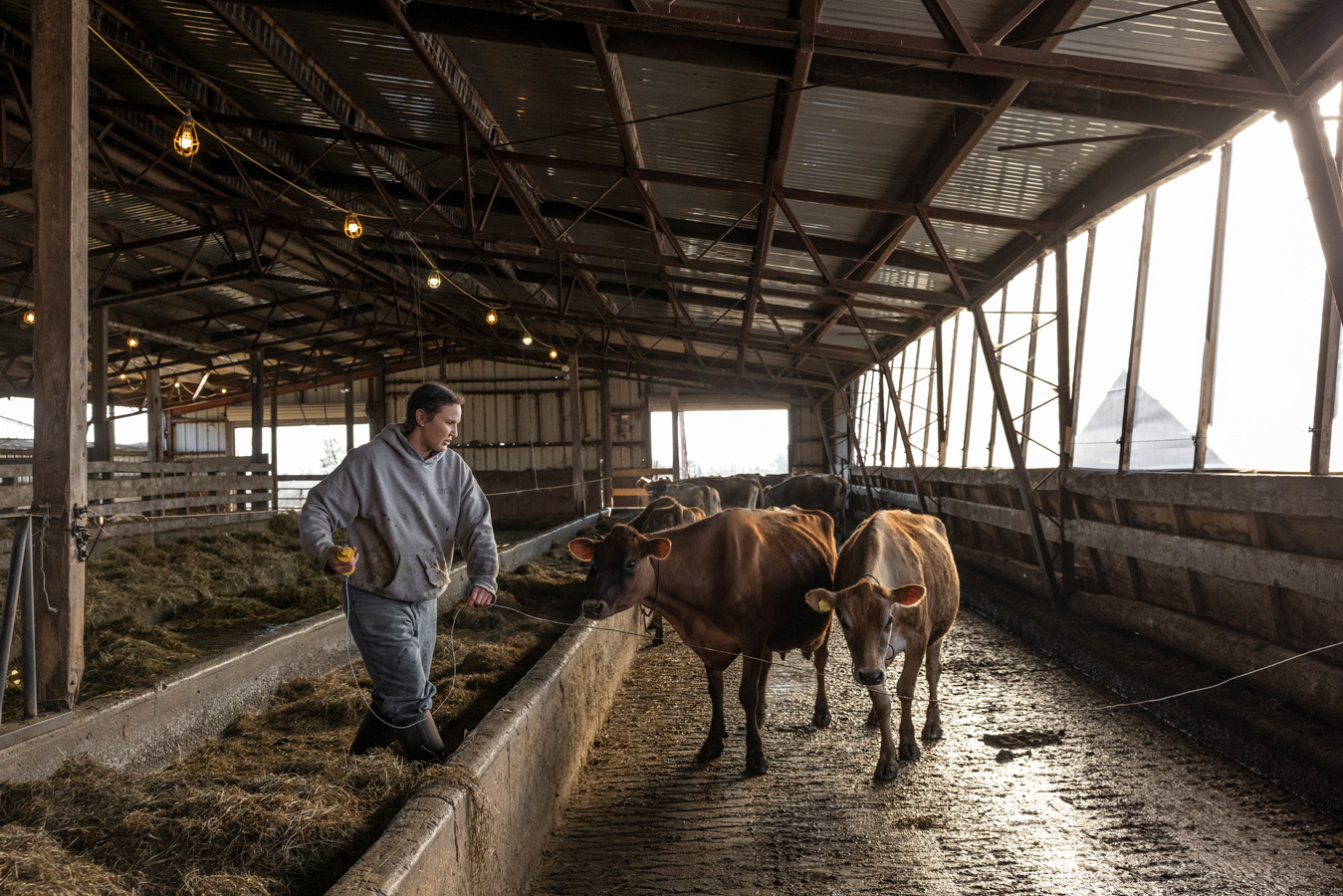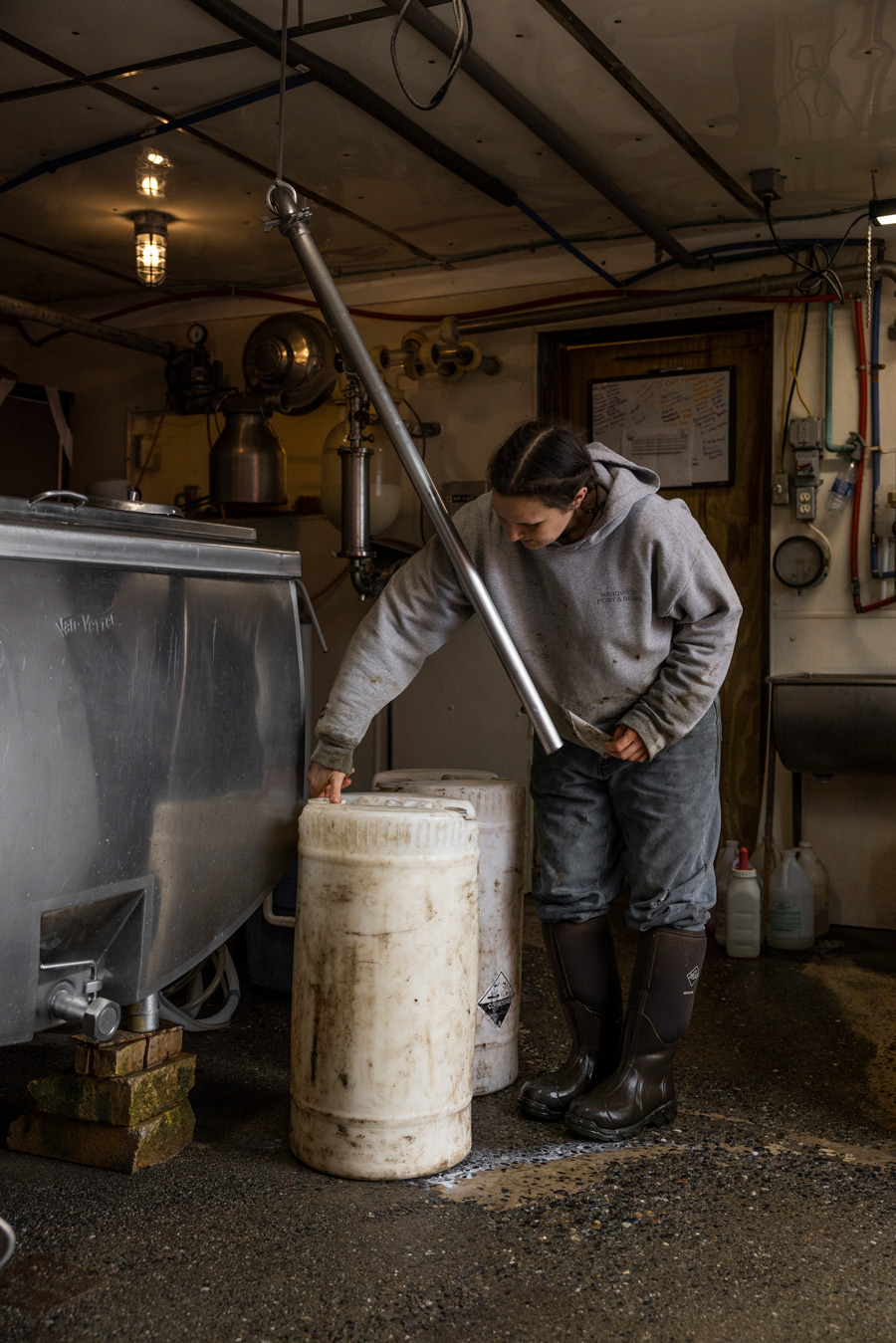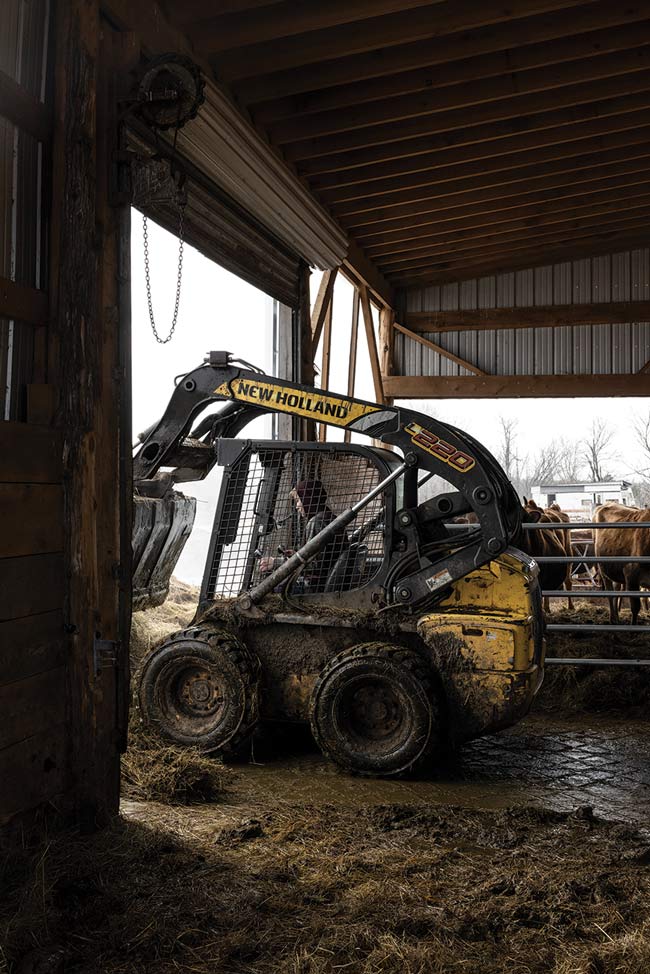By Kate Olson
Photographed By Greta Rybus
From our July 2022 issue
One summer morning in 1992, Henry Perkins had finished milking his herd of 80 Dutch Belted cows and was on to other chores when a pickup truck pulled up to his Albion farm. The man who stepped out said he was with BFI Organics, a waste-management company, and he told Perkins about a new, free source of nutrients for his land. The Portland Water District needed a way to dispose of what the industry calls sludge, a by-product of wastewater treatment containing the residue of household, municipal, and human waste. The sludge would come mixed with lime, the man said, to raise the PH of the soil. Perkins was curious, and when he asked around in the days that followed, he found that other farmers he knew — good ones, in his estimation — were already using this new fertilizer.
Perkins asked the BFI reps if it was safe. “And they said, ‘It’s completely safe. We test it for all the chemicals and all that,’” he recalls. “I was led to believe that it was benefitting society in general.”
Perkins used the free fertilizer for five years, then never thought any more of it. In 2013, he sold most of his farm and moved onto a remaining parcel up the road. The new owners, Katia and Brendan Holmes, named the operation Misty Brook Farm and diversified it to include sheep, pigs, and laying hens. Then, early last year, customers started asking whether they were testing their milk for PFAS.
“We said, ‘Okay, we can do that,’” Katia says. “‘And by the way, what is PFAS?’”



PFAS is an acronym for perfluoroalkyl and polyfluoroalkyl substances, often called “forever chemicals,” a class of at least 4,700 manufactured chemicals used in industrial processes and consumer goods since the 1940s, valued for their resistance to heat and water and their extreme durability. Among the most widely used and studied is perfluorooctanoic acid, or PFOA, essential to nuclear-weapons production during World War II and famously used to make Teflon. Over time, manufacturers found more and more applications for PFAS, and today, they’re found in outerwear, furniture, rugs, food packaging, cosmetics, cleaning products, and more. They’re used in firefighting and oil and gas fracking. In short, PFAS are all around us.
They are also in us. Highly mobile, PFAS are increasingly found in the food we eat, water we drink, and air we breathe. National sampling efforts conducted by the CDC have found PFAS in more than 98 percent of American blood samples. What makes the compounds industrially and commercially useful — their stubborn resistance to degradation — also makes them persist in the environment and accumulate in our bodies. High levels of PFAS exposure are associated with increased risk of kidney and testicular cancer, thyroid disease, reproductive complications, elevated cholesterol, and vaccine resistance in children.

In Maine, beginning in the 1980s, the state Department of Environmental Protection and sewer districts across the state began promoting the spreading of sewage sludge, sometimes known as biosolids, on farmland. The practice, widespread in all 50 states, had its genesis in the Clean Water Act, which set wastewater standards and provided funding for sewage-treatment plants. Spreading sludge seemed, at the time, like a win-win — free fertilizer for farmers and savings on landfill fees for municipalities. Today, Maine’s DEP knows of 700 sites across the state where “residuals” from both residential and industrial sources — including, in Maine, paper mills — were likely spread as fertilizer.
In 2016, an EPA test of unregulated contaminants found significant levels of PFAS in a public well not far from Stoneridge Farm, in Arundel. The next year, the state’s Department of Agriculture, Conservation, and Forestry found high levels of PFAS in milk from Stoneridge Farm. Although chemical companies have been quietly accumulating evidence of PFAS’s hazardous health effects since the 1960s, federal and state agencies have been slow to regulate and set safety standards. But as news of Stoneridge broke and concern grew in Maine over PFAS dairy contamination, the Maine CDC created an “action threshold” for one common type — called perfluorooctyl sulfonate, or PFOS — and DACF started conducting retail-milk tests. In 2020, one test revealed that milk from Fairfield’s Tozier Dairy Farm had PFOS concentrations of more than 150 times the state’s threshold for contamination — likely the highest PFAS concentration ever recorded in milk. Both the Arundel and Fairfield farms, it turned out, had participated in the sludge programs.
Last year, the DEP published a map of sites where historic licensing data shows biosolids may have been applied. Perkins’s land was on it, and when he tested his well water, the levels came back high. Down the road, at Misty Brook, the soil and water tested low for PFAS, but the milk tested high, as did some hay the Holmeses had bought from a nearby farm.
So the Holmeses called their buyers across the state and immediately pulled all of their products from the shelves. They were devastated. They told their 10 staff members that they didn’t know the extent of the contamination. “We went from full-on to zero income overnight,” Katia says.


Last fall, the DEP announced a testing program for all 700 sites, but the effort will take as long as four years to complete. In the meantime, some farms have begun testing proactively, and so far, 12 have identified contamination, either in milk or on their land or water. Many other farmers are afraid of losing their customers, land, and livelihoods if tests should reveal contamination. In February, Maine Farmland Trust and the Maine Organic Farmers and Gardeners Association set up a PFAS emergency-relief fund to pay for testing and replace income for farmers, as well as for food and medicine producers from Native communities.
“In a matter of weeks, our business went from forecasting for record growth for the 2022 season to insecurity about being able to pay our bills or see a clear path forward,” Adrienne Lee, of Knox’s New Beat Farm, told a state legislative committee in March. “The pride and confidence we had that we were feeding our family and our community safe and healthy food got crushed.” Beyond the economic and community impacts, Lee and her husband, Ken Lamson, worry about their health and that of their now–two-year-old daughter, whose blood-serum levels of PFOA registered 340 times higher than the average American’s.
For most farmers, anxiety over PFAS has to do with more than just the bottom line. “A lot of these farmers have that intimate relationship with the land,” Maine Farmland Trust president Amy Fisher says, “but 20 to 30 years ago, sludge was spread, before they owned their properties, and it feels like such a shock and a betrayal when they find out.”
Sludged farmland isn’t the only place in Maine where PFAS are turning up. Scientists are rapidly learning more about the ease with which these compounds can move through the soil, air, and water to be taken up by wildlife, plants, and trees. In 2021, the Maine Department of Inland Fish and Wildlife posted a “do not eat” alert for deer in and around Fairfield, a hotspot of PFAS contamination, due in part to a history of spread sludge from paper mills. Scientists have also documented so much PFAS contamination in Maine’s freshwater fish that the state CDC is considering adjusting warnings for fish consumption.
In 2018, Dan Kusnierz, head of water resources for the Penobscot Nation, requested federal researchers measure PFAS levels in a study of anadromous fish (those that move between the ocean and fresh water) in the Penobscot River. The results showed levels high enough to cause health effects, particularly if consumed frequently. It was, Kusnierz says, “pretty devastating.” Wild foods are critically important to the Penobscot Nation, both for nutrition and for cultural significance, and although its citizens hunt, fish, and forage across the state, they are particularly reliant on fish from the Penobscot, where they have sustenance-fishing rights. Among other potential pathways, sludge is deposited in the Juniper Ridge Landfill, a state-owned but privately operated facility on the river, near the Penobscot Indian Island Reservation. Runoff from that sludge, called leachate, is then taken to a wastewater-treatment plant at Orono’s Nine Dragons Paper Mill, which is not equipped to filter out PFAS before discharging treated water into the river.
Tribal members, Kusnierz says, are unnerved. “I’ve had people in tears being scared about what’s happening to their river. They want to be able to feel safe about eating fish from it, and they can’t.”

At least 32 states will consider PFAS regulation this year, and Maine is at the leading edge of both gauging the extent of contamination and proposing legislative and economic solutions. A nascent collaboration among several state agencies and the University of Maine is examining possibilities for phyto-remediation, using plants to pull PFAS out of the soil. In the absence of federal safety standards for food, the Maine CDC is helping farmers interpret test results. Last summer, Maine lawmakers passed a suite of PFAS-related bills, which included setting the country’s strictest standards for PFAS concentrations in drinking water and a first-in-the-nation ban on PFAS in consumer products, to be phased in by 2030. This April, in another round of other PFAS legislation, the state banned the land application of PFAS-contaminated sludge and mandated a study on treating leachate from state-owned landfills like Juniper Ridge. It also passed a budget with $60 million to fund health monitoring and income-replacement and buy-back programs for affected farmers, plus more than $6 million to support state agencies’ research, testing, and mitigation efforts.
Organizing on the part of farmers has been crucial in galvanizing state support. “The way the farmers have responded to this challenge speaks to the strength of the network and the food community here,” Fisher says. “By the time other states wake up to this issue, Maine will be way out of the gate and will be showing other states how to navigate.”



“This can’t get swept under the rug again,” says Misty Brook Farm’s Katia Holmes. “DuPont and 3M started realizing this was a problem back in the ’70s. This poisoning of land and plants and animals has been going on way too long.”
The Holmeses have found a path forward since discovering PFAS contamination in their farm’s milk. The parcel on which Henry Perkins allowed sludge in the ’90s was relatively small, and it remains a part of Perkins’s neighboring property today, not the Holmeses’. Misty Brook’s cows, it turns out, were contaminated by the hay they’d purchased from another farm. After buying new, PFAS-free cows and testing their hay, they’ve continued selling milk. But their story indicates the frustratingly unpredictable ways in which PFAS move through our environment: even a farm with no on-site contamination is in danger of unknowingly introducing it with PFAS-laced feed. And because PFAS can move through the environment in insidious ways, soil contamination in one plot now could mean future water contamination nearby.
When he reflects today on his small role in the crisis, Perkins is deeply troubled. “It makes me sick to my stomach,” the 70-year-old retired farmer says. “I wanted to leave this place in a better place than I came upon it, and I don’t know whether that’s gonna happen or not. I feel a little bit betrayed.”




